Branding is a formidable pillar that holds the identity and values of a business. It’s not just about a captivating logo or a catchy slogan; it’s a blend of multiple elements that work in synergy to create a unique image in the consumer’s mind.
According to Forbes, being consistent when you present your brand identity can increase your revenue by up to 23%. That’s why the relevance of branding in today’s market is paramount, as it significantly influences consumer perceptions and decisions. Discover more about branding.
This article explores the vast spectrum of Branding Elements, dissecting each one to understand its significance and how it contributes to building a remarkable brand identity.
Branding Elements
Branding isn’t a one-size-fits-all kind of deal; it’s a tailored suit that should fit your business impeccably. However, there are certain universal elements that lay the foundation of any brand. These core Branding Elements are the building blocks that help in carving out a distinct identity in a crowded marketplace.
Core Branding Elements
Under this umbrella, we find the quintessential elements that are almost synonymous with the term branding. They are the first things that pop into mind when one mentions the word ‘brand.’
1. Logo
A logo is the face of a brand. It’s the first thing that people notice and remember about a brand. A well-designed logo can set the right tone and convey the brand’s personality succinctly.
Examples :
Apple’s apple, McDonald’s golden arches, and Nike’s swoosh are all epitomes of iconic logos that are recognised globally.
2. Colour Palette

Colours evoke emotions and convey messages non-verbally. They play a pivotal role in creating a brand’s perception. 80% of consumers said brand recognition can increase with a consistent colour palette for your logo, content, and promotional materials. (Source).
Examples:
The colour red in Coca-Cola’s branding invokes excitement and boldness, while the blue in Facebook’s logo symbolises trust and dependability.
3. Typography

Typography reflects a brand’s voice. The typefaces chosen can significantly impact how the message is received by the audience.
Examples:
The elegant serif font of Vogue portrays sophistication, while the bold, sans-serif font of Netflix exudes modernity and excitement.
4. Taglines and Slogans

A catchy tagline or slogan encapsulates the brand’s promise and value proposition in a nutshell.
Examples:
Nike’s “Just Do It” or McDonald’s “I’m Lovin’ It” are catchy, memorable, and resonate with their target audience.
5. Imagery

Images convey what words can’t. They help in creating a visual identity that complements the brand’s message and values.
Examples:
Instagram’s use of vibrant and visually appealing imagery aligns with its brand promise of sharing life’s moments through photos.
These core elements are just the tip of the iceberg, but they hold immense significance in the brand-building journey. Every colour, image, and word chosen reflects the brand’s ethos and values, which is why it’s imperative to choose them wisely.
Extended Branding Elements
Moving beyond the core, there are other elements that add depth to the brand’s identity, making it more relatable and human.
1. Mission and Vision Statements
Creating Resonating Statements: A brand’s mission and vision statements are its heart and soul. They articulate the brand’s purpose, ambitions, and the values that drive it.
Examples:
Google’s mission “to organise the world’s information and make it universally accessible and useful” showcases its ambition and the value it provides to its users.
2. Brand Culture
Developing Authentic Brand Culture: Culture is not just about plastering values on the office walls; it’s about living those values every day.
Examples: The culture of innovation and customer-centricity at Amazon is well-known and is a big part of its brand identity.
3. Brand Voice and Vocabulary
Establishing a Unique Brand Voice: A distinct brand voice makes a brand recognisable even without visual elements.
Examples:
The quirky and humorous voice of Old Spice stands out in a sea of conventional deodorant brands.
4. Packaging
Role in Brand Perception: Packaging is a physical manifestation of the brand’s quality and aesthetics.
Examples:
Apple’s minimalist and premium packaging reflects its brand’s promise of delivering high-quality, sleek products.
5. Positioning
Establishing a Competitive Position: Positioning sets a brand apart from its competitors and defines its place in the market. You can learn more about how Brand Positioning can make you standing out in a competitive market
Examples:
Tesla’s positioning as a leader in electric vehicles and sustainable energy sets it apart in the automotive industry.
Incorporating these extended elements helps in painting a fuller picture of the brand, making it more relatable and resonating with the audience.
Conclusion
Embarking on the branding journey is a pivotal step for any business. The elements discussed in this segment form the cornerstone of how a brand is perceived by the outside world.
They are not merely aesthetic or superficial facets, but are deeply intertwined with the brand’s identity and its narrative. The careful orchestration of these elements can significantly elevate a brand’s position in the market, making it a recognizable and trustworthy name among consumers.
As we transition into the practical aspect of implementing these elements in the next segment, it’s essential to have a thorough understanding and a well-thought-out strategy.
Neu Entity offers a structured approach towards brand building, ensuring that every aspect of branding is meticulously crafted to resonate with the intended audience. With a solid foundation, a brand is well on its way to creating a lasting imprint in the consumer’s mind.
Let’s Talk!
If what you see here is relevant for you and can help you grow your business or organisation, we’d love to discuss further with you. Drop us a message or schedule an appointment with us.
